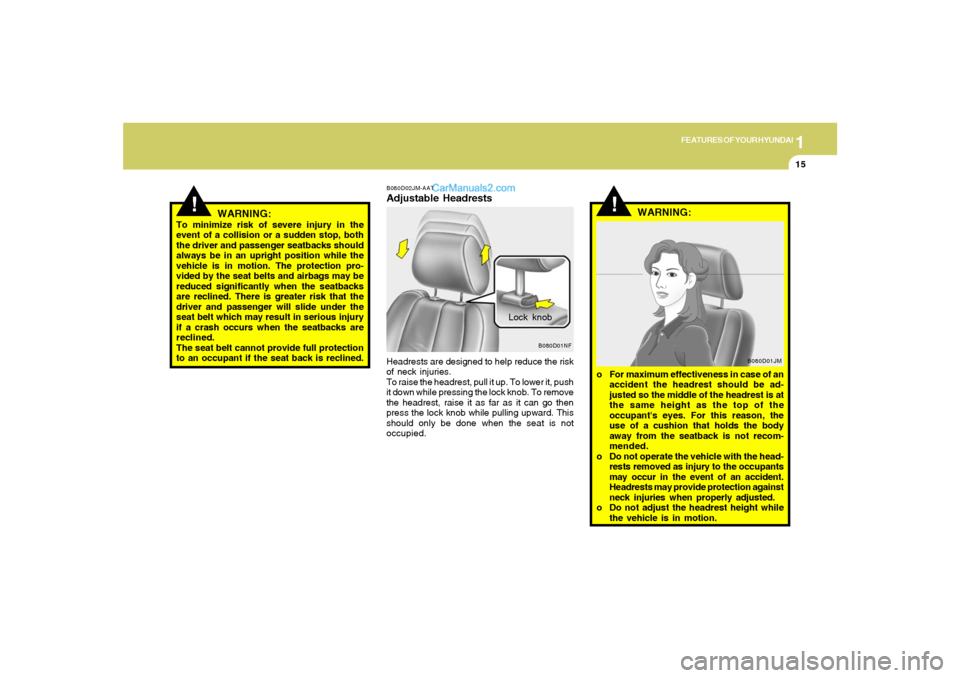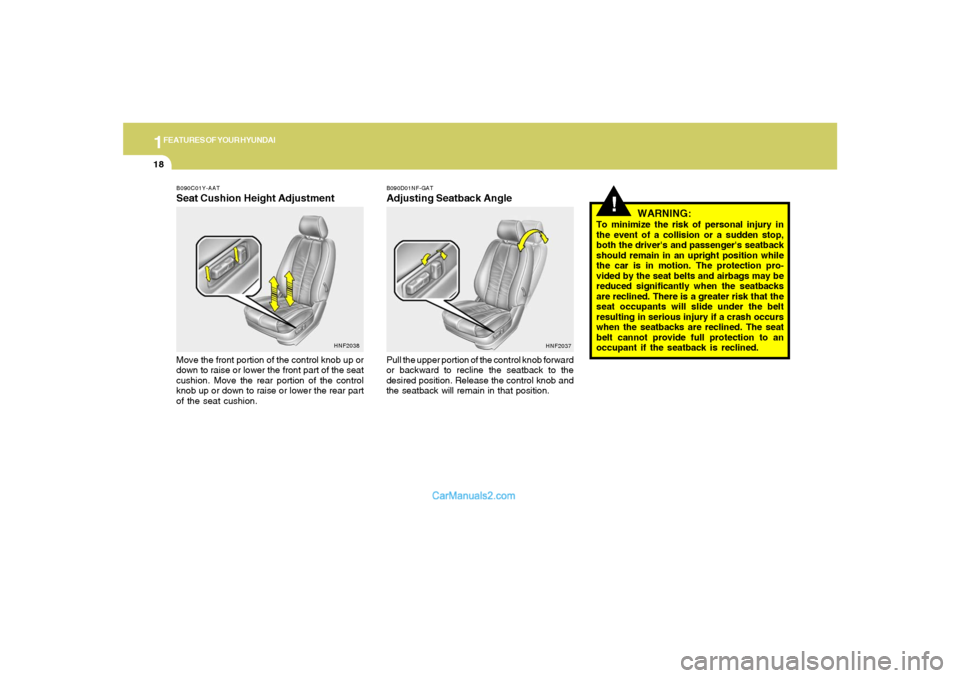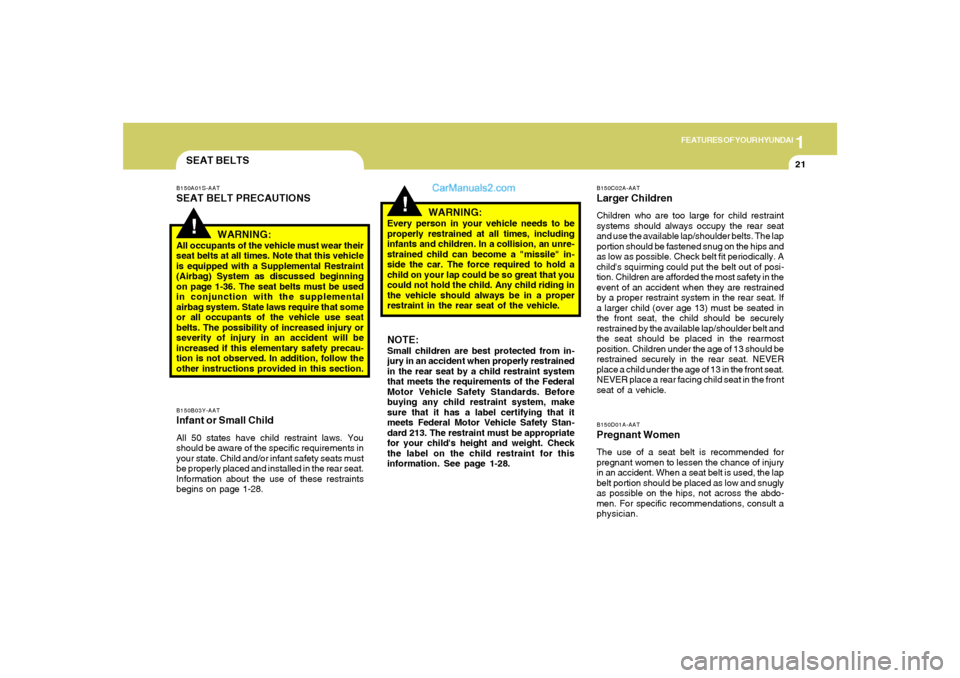2005 Hyundai Sonata warning
[x] Cancel search: warningPage 26 of 271

1
FEATURES OF YOUR HYUNDAI
13
!
!
HNF2018
Close
Open
WARNING:
o Be careful that someone's head, hands
and body are not trapped by a closing
window.
o Never try to operate the main switch on
the driver's door and the individual door
window switch in opposing directions
at the same time. If this is done, the
window will stop and cannot be opened
or closed.
o Do not leave children alone in the car.
o Never leave the ignition key in the car.
WARNING:
o The automatic reverse window will only
operate when the automatic up window
operation feature is used. The automatic
reverse feature of the window will not
operate if the window is raised using the
halfway position on the power window
switch.
o If an object less than 0.16 in.(4 mm) in
diameter is caught between the window
glass and the upper window channel,
the automatic reverse window may not
detect the resistance and will not stop
and reverse direction. Therefore, always
check for any obstructions before rais-
ing any window.B060C01NF-AATAutomatic Reverse Window
(Driver's side)If the upward movement of the window is blocked
by an object or part of the body, the window will
detect the resistance and will stop upward
movement. The window will then lower approxi-
mately 11.8 in.(30cm) to allow the object to be
cleared.
NOTE:The power windows can be operated for 30
seconds after the ignition key is turned to
the "ACC" or "LOCK" positions, or removed
from the ignition switch.
If the front doors are opened during this 30
second period, the power windows can no
longer be operated without the ignition key
turned to the "ON" position.
Page 27 of 271

1FEATURES OF YOUR HYUNDAI14
!
B080B02A-AATAdjusting Seat Forward and RearwardTo move the seat toward the front or rear, pull
the lock release lever upward. This will release
the seat on its track so you can move it forward
or rearward to the desired position. When you
find the position you want, release the lever and
slide the seat forward or rearward on its track
until it locks into the desired position and cannot
be moved further.
B080C01A-AATAdjusting Seatback AngleTo recline the seatback, lean forward to take
your weight off it, then pull up on the recliner
control lever at the outside edge of the seat. Now
lean back until the desired seatback angle is
achieved. To lock the seatback into position,
release the recliner control lever.
WARNING:
To ensure the seat is locked securely, at-
tempt to move the seat forward or rearward
without using the lock release lever.
SEATSB080A01A-AATADJUSTABLE FRONT SEATS
!
WARNING:
Never attempt to adjust the seat while the
vehicle is moving. This could result in loss
of control or an accident which may cause
death, serious injury, or property damage.
HNF2032
HNF2033
Page 28 of 271

1
FEATURES OF YOUR HYUNDAI
15
!
WARNING:
To minimize risk of severe injury in the
event of a collision or a sudden stop, both
the driver and passenger seatbacks should
always be in an upright position while the
vehicle is in motion. The protection pro-
vided by the seat belts and airbags may be
reduced significantly when the seatbacks
are reclined. There is greater risk that the
driver and passenger will slide under the
seat belt which may result in serious injury
if a crash occurs when the seatbacks are
reclined.
The seat belt cannot provide full protection
to an occupant if the seat back is reclined.
!
B080D02JM-AATAdjustable HeadrestsHeadrests are designed to help reduce the risk
of neck injuries.
To raise the headrest, pull it up. To lower it, push
it down while pressing the lock knob. To remove
the headrest, raise it as far as it can go then
press the lock knob while pulling upward. This
should only be done when the seat is not
occupied.
WARNING:
o For maximum effectiveness in case of an
accident the headrest should be ad-
justed so the middle of the headrest is at
the same height as the top of the
occupant's eyes. For this reason, the
use of a cushion that holds the body
away from the seatback is not recom-
mended.
o Do not operate the vehicle with the head-
rests removed as injury to the occupants
may occur in the event of an accident.
Headrests may provide protection against
neck injuries when properly adjusted.
o Do not adjust the headrest height while
the vehicle is in motion.
B080D01JM
B080D01NF
Lock knob
Page 30 of 271

1
FEATURES OF YOUR HYUNDAI
17
!
B090A01Y-AATPOWER DRIVER'S SEAT (If Installed)The driver's seat can be adjusted by using the
control knobs on the left side of the seat. Before
driving, adjust the seat to the proper position so
as to easily control the steering wheel, pedals
and switches on the instrument panel.
CAUTION:
Do not operate two knobs at the same time.
WARNING:
o Never attempt to adjust the seat while
the vehicle is moving. This could result
in loss of control or an accident causing
death, serious injury, or property dam-
age.
o Do not sit or lean unnecessarily close to
the airbag.
!
B080F01NF-GATSeat Height Adjustment
(Driver's Seat Only)To raise or lower the seat, raise or lower the
control lever to the desired seat height.
HNF2034
B090B01NF-GATAdjusting Seat Forward and RearwardPull the control knob forward or backward to
move the seat forward or backward to the
desired position. Release the control knob and
the seat will remain at that position.
HNF2036
Page 31 of 271

1FEATURES OF YOUR HYUNDAI18
!
WARNING:
To minimize the risk of personal injury in
the event of a collision or a sudden stop,
both the driver's and passenger's seatback
should remain in an upright position while
the car is in motion. The protection pro-
vided by the seat belts and airbags may be
reduced significantly when the seatbacks
are reclined. There is a greater risk that the
seat occupants will slide under the belt
resulting in serious injury if a crash occurs
when the seatbacks are reclined. The seat
belt cannot provide full protection to an
occupant if the seatback is reclined.
B090D01NF-GATAdjusting Seatback AnglePull the upper portion of the control knob forward
or backward to recline the seatback to the
desired position. Release the control knob and
the seatback will remain in that position.
B090C01Y-AATSeat Cushion Height AdjustmentMove the front portion of the control knob up or
down to raise or lower the front part of the seat
cushion. Move the rear portion of the control
knob up or down to raise or lower the rear part
of the seat cushion.
HNF2038
HNF2037
Page 32 of 271

1
FEATURES OF YOUR HYUNDAI
19
!
B100A01NF-AATSEAT WARMER (If Installed)The seat warmer is provided to warm the front
seats during cold weather. With the ignition key
in the "ON" position, push either of the switches
to warm the driver's seat or the front passenger's
seat.
During mild weather or under conditions where
the operation of the seat warmer is not needed,
keep the switches in the "OFF" position.NOTE:o The seat warmer may not operate if the
ambient temperature is warm.
o If the seat warmer doesn't operate when
the ambient temperature is lower than
75.2°F (24°C), it must be checked at an
authorized dealer.
B100A01NF
WARNING:
Do not turn on the seat warmers, if the seat
is occupied by someone who cannot moni-
tor the temperature and turn off the seat
warmer, if it becomes too warm. The seat
warmers should not be turned on when
children, the elderly, ill people, and sleep-
ing people occupy the seat.
B110A01NF-GATFOLDING REAR SEATBACKSo To unlock the seatback, pull the seatback
release lever, then pull forward on the
seatback panel.
o When you return the seatback to its upright
position, always be sure it has locked into
position by pulling and pushing on the top of
the seatback.
B110A01NF-A
Page 33 of 271

1FEATURES OF YOUR HYUNDAI20
!
B140A01S-AATREAR SEAT WARNINGFor the safety of all passengers, luggage or
other cargo should not be piled higher than the
top of the seatback. In addition, do not place
objects on the rear shelf as they may move
forward during braking or in an accident and
may strike and injure vehicle passengers.
B140A01NF-A
!
WARNING:
The purpose of the folding rear seatbacks
is to allow you to carry longer objects than
could otherwise be accommodated. Do not
allow passengers to sit on top of the folded
down seatback, while the car is moving as
this is not a proper seating position and no
seat belts are available for use. This could
result in serious injury or death in case of an
accident or sudden stop. Objects carried
on the folded down seatback should not
extend higher than the top of the front
seats. This could allow cargo to slide for-
ward and cause injury or damage during
sudden stops.
B120A01NF-GATREAR SEATBACK SAFETY LOCKIf the rear seatback lock knob (located on the
backside of the rear seatback) is in the "LOCK"
position when the rear seatbacks are upright
and closed, it will not be possible to fold the rear
seatback by using the seatback release lever.
In this instance, move the lock knob to the
"UNLOCK" position and fold the rear seatback.
The rear seatback lock knob is designed to
provide protection from unauthorized entry into
the trunk.
B120A01NF-A
Page 34 of 271

1
FEATURES OF YOUR HYUNDAI
21
SEAT BELTSB150B03Y-AATInfant or Small ChildAll 50 states have child restraint laws. You
should be aware of the specific requirements in
your state. Child and/or infant safety seats must
be properly placed and installed in the rear seat.
Information about the use of these restraints
begins on page 1-28.
!
B150A01S-AATSEAT BELT PRECAUTIONS
WARNING:All occupants of the vehicle must wear their
seat belts at all times. Note that this vehicle
is equipped with a Supplemental Restraint
(Airbag) System as discussed beginning
on page 1-36. The seat belts must be used
in conjunction with the supplemental
airbag system. State laws require that some
or all occupants of the vehicle use seat
belts. The possibility of increased injury or
severity of injury in an accident will be
increased if this elementary safety precau-
tion is not observed. In addition, follow the
other instructions provided in this section.
!
WARNING:
Every person in your vehicle needs to be
properly restrained at all times, including
infants and children. In a collision, an unre-
strained child can become a "missile" in-
side the car. The force required to hold a
child on your lap could be so great that you
could not hold the child. Any child riding in
the vehicle should always be in a proper
restraint in the rear seat of the vehicle.NOTE:Small children are best protected from in-
jury in an accident when properly restrained
in the rear seat by a child restraint system
that meets the requirements of the Federal
Motor Vehicle Safety Standards. Before
buying any child restraint system, make
sure that it has a label certifying that it
meets Federal Motor Vehicle Safety Stan-
dard 213. The restraint must be appropriate
for your child's height and weight. Check
the label on the child restraint for this
information. See page 1-28.
B150C02A-AATLarger ChildrenChildren who are too large for child restraint
systems should always occupy the rear seat
and use the available lap/shoulder belts. The lap
portion should be fastened snug on the hips and
as low as possible. Check belt fit periodically. A
child's squirming could put the belt out of posi-
tion. Children are afforded the most safety in the
event of an accident when they are restrained
by a proper restraint system in the rear seat. If
a larger child (over age 13) must be seated in
the front seat, the child should be securely
restrained by the available lap/shoulder belt and
the seat should be placed in the rearmost
position. Children under the age of 13 should be
restrained securely in the rear seat. NEVER
place a child under the age of 13 in the front seat.
NEVER place a rear facing child seat in the front
seat of a vehicle.B150D01A-AATPregnant WomenThe use of a seat belt is recommended for
pregnant women to lessen the chance of injury
in an accident. When a seat belt is used, the lap
belt portion should be placed as low and snugly
as possible on the hips, not across the abdo-
men. For specific recommendations, consult a
physician.